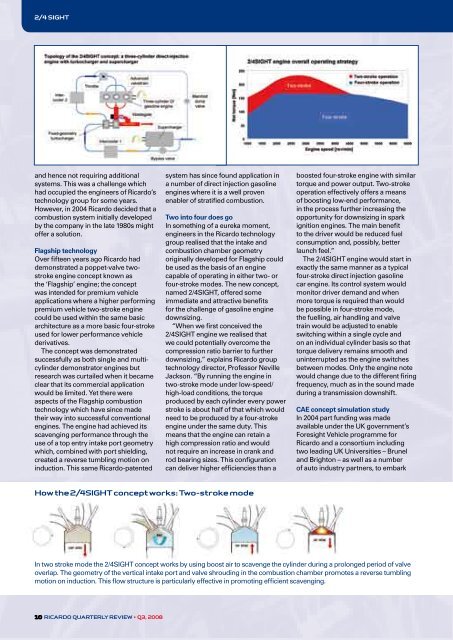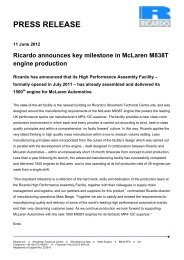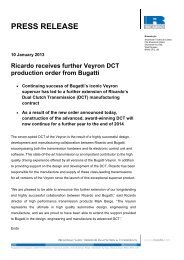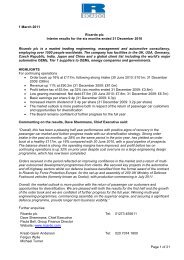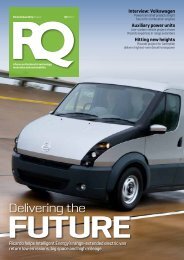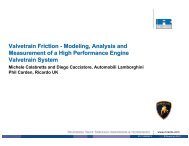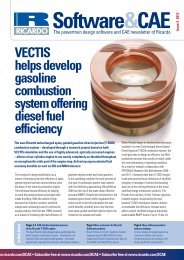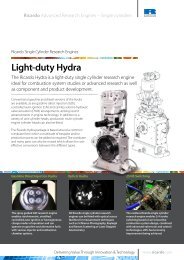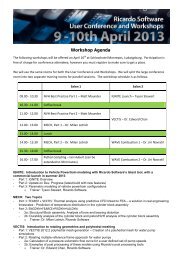Case Study - Ricardo
Case Study - Ricardo
Case Study - Ricardo
You also want an ePaper? Increase the reach of your titles
YUMPU automatically turns print PDFs into web optimized ePapers that Google loves.
2/4 SIGHT<br />
and hence not requiring additional<br />
systems. This was a challenge which<br />
had occupied the engineers of <strong>Ricardo</strong>’s<br />
technology group for some years.<br />
However, in 2004 <strong>Ricardo</strong> decided that a<br />
combustion system initially developed<br />
by the company in the late 1980s might<br />
offer a solution.<br />
Flagship technology<br />
Over fifteen years ago <strong>Ricardo</strong> had<br />
demonstrated a poppet-valve twostroke<br />
engine concept known as<br />
the ‘Flagship’ engine; the concept<br />
was intended for premium vehicle<br />
applications where a higher performing<br />
premium vehicle two-stroke engine<br />
could be used within the same basic<br />
architecture as a more basic four-stroke<br />
used for lower performance vehicle<br />
derivatives.<br />
The concept was demonstrated<br />
successfully as both single and multicylinder<br />
demonstrator engines but<br />
research was curtailed when it became<br />
clear that its commercial application<br />
would be limited. Yet there were<br />
aspects of the Flagship combustion<br />
technology which have since made<br />
their way into successful conventional<br />
engines. The engine had achieved its<br />
scavenging performance through the<br />
use of a top entry intake port geometry<br />
which, combined with port shielding,<br />
created a reverse tumbling motion on<br />
induction. This same <strong>Ricardo</strong>-patented<br />
system has since found application in<br />
a number of direct injection gasoline<br />
engines where it is a well proven<br />
enabler of stratified combustion.<br />
Two into four does go<br />
In something of a eureka moment,<br />
engineers in the <strong>Ricardo</strong> technology<br />
group realised that the intake and<br />
combustion chamber geometry<br />
originally developed for Flagship could<br />
be used as the basis of an engine<br />
capable of operating in either two- or<br />
four-stroke modes. The new concept,<br />
named 2/4SIGHT, offered some<br />
immediate and attractive benefits<br />
for the challenge of gasoline engine<br />
downsizing.<br />
“When we first conceived the<br />
2/4SIGHT engine we realised that<br />
we could potentially overcome the<br />
compression ratio barrier to further<br />
downsizing,” explains <strong>Ricardo</strong> group<br />
technology director, Professor Neville<br />
Jackson. “By running the engine in<br />
two-stroke mode under low-speed/<br />
high-load conditions, the torque<br />
produced by each cylinder every power<br />
stroke is about half of that which would<br />
need to be produced by a four-stroke<br />
engine under the same duty. This<br />
means that the engine can retain a<br />
high compression ratio and would<br />
not require an increase in crank and<br />
rod bearing sizes. This configuration<br />
can deliver higher efficiencies than a<br />
boosted four-stroke engine with similar<br />
torque and power output. Two-stroke<br />
operation effectively offers a means<br />
of boosting low-end performance,<br />
in the process further increasing the<br />
opportunity for downsizing in spark<br />
ignition engines. The main benefit<br />
to the driver would be reduced fuel<br />
consumption and, possibly, better<br />
launch feel.”<br />
The 2/4SIGHT engine would start in<br />
exactly the same manner as a typical<br />
four-stroke direct injection gasoline<br />
car engine. Its control system would<br />
monitor driver demand and when<br />
more torque is required than would<br />
be possible in four-stroke mode,<br />
the fuelling, air handling and valve<br />
train would be adjusted to enable<br />
switching within a single cycle and<br />
on an individual cylinder basis so that<br />
torque delivery remains smooth and<br />
uninterrupted as the engine switches<br />
between modes. Only the engine note<br />
would change due to the different firing<br />
frequency, much as in the sound made<br />
during a transmission downshift.<br />
CAE concept simulation study<br />
In 2004 part funding was made<br />
available under the UK government’s<br />
Foresight Vehicle programme for<br />
<strong>Ricardo</strong> and a consortium including<br />
two leading UK Universities – Brunel<br />
and Brighton – as well as a number<br />
of auto industry partners, to embark<br />
How the 2/4SIGHT concept works: Two-stroke mode<br />
In two stroke mode the 2/4SIGHT concept works by using boost air to scavenge the cylinder during a prolonged period of valve<br />
overlap. The geometry of the vertical intake port and valve shrouding in the combustion chamber promotes a reverse tumbling<br />
motion on induction. This flow structure is particularly effective in promoting efficient scavenging.<br />
10 RICARDO QUARTERLY REVIEW • Q3, 2008


